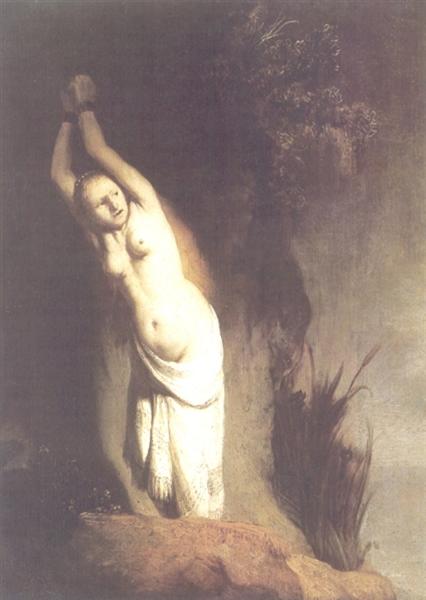Description
The work "Andromeda" of Rembrandt, created in 1631, is a fascinating example of the use of chiaroscuro and emotional drama that characterize this master of the art of the seventeenth century. This painting, inspired by Greek mythology, illustrates the moment when Andromeda, a young woman tied to a rock as a sacrifice to a marine monster, is rescued by Perseus, who appears in the sky mounted on her winged horse, Pegasus. The mythical narrative behind the work adds a rich context that is reflected in the composition and the characters.
The central figure of Andromeda is represented in a way that evokes deep vulnerability. She is naked, which not only underlines her fragility in the face of imminent danger, but also refers to the idealization of female beauty that prevails in the art of the Renaissance and the Baroque. Andromeda's body is twisted in a position loaded with tension, showing both his fear and his resistance. The way Rembrandt captures light on its skin, moving from warm brightness in the illuminated areas in subtle and deep shadows, is a testimony of its technical mastery.
The use of color in this work is both dramatic and symbolic. The palette of terrible and dark tones contributes to the dreary atmosphere of the work, reflecting the danger that lurks to Andromeda. The dim light that bathes its figure and the rock where it is chained contrasts with the dark background, suggesting both the hope of its rescue and the imminent danger that the monster represents. The figure of Perseus, although distant and barely visible, is presented surrounded by clouds and with a bright armor, symbolizing heroism and salvation.
Rembrandt, known for its ability to capture emotion and psychology through the innovative use of light and shadow, not only illustrates the mythological event, but also adds a layer of emotional depth that invites the viewer to empathize with despair from Andromeda. This approach to human expression becomes a distinctive feature of Rembrandt's art, who manages to transform mythical narrative into a meditation on vulnerability and hope.
This painting, Although less known than other artist's masterpieces, such as "La Ronda de Noche" or "The Lesson of Anatomy of Dr. Tulp", is emblematic of his style and the cultural context of his time. In the context of the Baroque, where drama and emotion were central, Rembrandt stands out for its ability to combine elements of narration with a realistic representation of the human condition.
In short, the "Andromeda" of 1631 is a work that encapsulates the aesthetic and philosophical concerns of Baroque art, showing the mastery of Rembrandt in the representation of the human being in the context of light and shadow, and its deep understanding of the human emotions. This painting not only invites admiration for its sublime technique and its reflexive composition, but also confronts us with the eternal conflict between fear and hope, vulnerability and heroism.
KUADROS ©, a famous paint on your wall.
Hand-made oil painting reproductions, with the quality of professional artists and the distinctive seal of KUADROS ©.
Reproduction service paintings With a guarantee of satisfaction. If you are not completely satisfied with the replica of your painting, we refund your money 100%.

